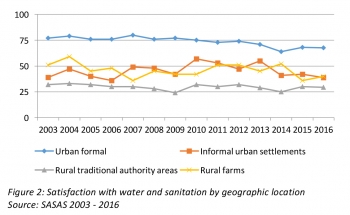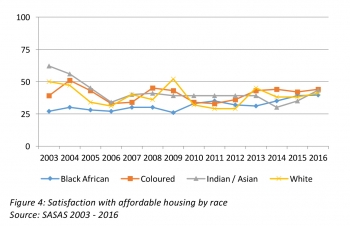Perceptions of socio-economic circumstances: Survey indicates a daunting task lies ahead
In President Cyril Ramaphosa’s first speech in Parliament, during which he accepted his nomination as president, he emphasised the importance of improving the standard of living of all South Africans. In the light of the current perceptions of socio-economic conditions in South Africa, he faces a formidable task, write Dr Yul Derek Davids and Prof Mia Swart.
The South African Constitution is regarded as one of the most progressive in the world. One of its central features is the recognition of the right of all citizens to certain socio-economic rights including basic housing, healthcare, education, food, water, and social security. Including socio-economic rights in the Constitution has direct, practical implications for government, which is expected to fulfil these rights through concrete action. It is crucial that government’s progress in delivering on these expectations is monitored.
The HSRC’s South African Social Attitude Survey (SASAS) series is a useful tool to measure the extent to which South Africans are satisfied with their socio-economic circumstances, but the series does not measure the extent to which government has complied with its obligation to progressively realise socio-economic rights. Such a measurement would require insight into the national budget and what portion of the budget the state dedicates to socio-economic goods. However, how South Africans perceive their circumstances matter and it provides valuable insight into how government has fared in providing basic goods such as water, sanitation, housing and electricity.
What is the SASAS series?
The HSRC has conducted an annual cross-national opinion survey since 2003. The SASAS series measures the public’s attitudes and beliefs on a range of issues such as democracy and governance. The surveys are designed to yield a representative sample of approximately 3 000 people who are 16 years and older and who live in private homes in South Africa regardless of their nationality or citizenship. Figure 1 shows the broad range of socio-economic areas measured by the SASAS survey.
The respondents were asked “How satisfied or dissatisfied are you with the way that the government is handling the following matters in your neighbourhood?” The survey assessed satisfaction levels in terms of a broad range of socio-economic goods, including the supply of water and sanitation, electricity provision, affordable housing and access to healthcare. The findings presented in this article contribute to the work of the HSRC’s Democracy, Governance and Service Delivery Transformative Governance project.
Key findings
Given the severe drought in the Western Cape and other parts of the country, the perceptions of government’s provision of water is particularly interesting. The lower level of public satisfaction in this area can be attributed to the inadequate manner in which government is dealing with the water crisis. Figure 1 shows that satisfaction with water and sanitation received fairly consistent ratings between 2003 and 2013 (ranging from 57% to 62%). However, the level of satisfaction dropped slightly to 53% in 2014 and 2016. When the data from 2003 to 2016 is disaggregated, we find that rural dwellers were the least satisfied (30%) with water provision, followed by residents of informal settlements (45%) (Figure 2). Consumers in formal urban areas were on average, more satisfied with municipal efforts in providing these basic household services (74%).
Overall, 65% of surveyed South Africans were satisfied with electricity provision (Figure 1). From 2003 to 2016, satisfaction levels for electricity provision were also consistently higher than for water provision. However, electricity provision remains a challenge. This can partly be attributed to problems besetting Eskom, including a management crisis, lack of capacity and maintenance backlogs. It is therefore unsurprising that SASAS reported the lowest level of electricity provision satisfaction in 2014 (53%), when these difficulties were most felt by the public. Black African respondents remained the least satisfied (63%) with the provision of electricity, compared with coloured (74%), Indian (73%) and white adults (73%) (Figure 3).
Between 2003 and 2012, affordable housing was one of the top 10 problems that South Africans faced. It was mentioned by about 11% of survey respondents. While government’s major focus has been on the provision of low-cost housing in urban South Africa, there is growing concern about the social and environmental sustainability of housing programmes.
Figure 1 shows that, from 2003 to 2016, South Africans were least satisfied with low-cost housing. Although 2016 recorded the highest level of satisfaction (40%), it still remained low for all the previous years with a national average of 34%. Black African respondents were the least satisfied with low-cost housing, with this trend varying since 2010 by marginal percentages (Figure 4). On average, 32% of black Africans were satisfied, compared with 40% of coloured, 42% of Indian and 39% of white respondents.
The health status of black South Africans continued to be lower than other racial groups. There were also large differences in the life expectancy and mortality rates among black, coloured, Indian and white respondents. These stark inequalities can be attributed to higher levels of poverty among most black South Africans. Figure 1 indicates that access to healthcare received fairly consistent ratings from 2004 to 2016 (fluctuating between 51% and 59%). Nevertheless, the fact that just more than half (53%) of South Africans were satisfied with their access to healthcare indicates a crisis in the healthcare system. It is clear that the provision of free basic medical care is insufficient.
The overall picture
The survey results paint a fairly bleak picture, particularly as the findings remained relatively consistent between 2003 and 2016, indicating little improvement in socio-economic satisfaction levels over time. The fact that black South Africans were consistently the least satisfied group is not surprising. It points to a failure in fulfilling the constitutional objective of equality. Overall, the low satisfaction levels suggest that the state has not fulfilled its obligation to progressively realise socio-economic rights, and South Africans believe that the government is lagging behind addressing socio-economic inequalities.
Authors: Dr Yul Derek Davids, chief research specialist, and Prof Mia Swart, research director, of the HSRC’s Democracy, Governance and Service Delivery programme and visiting fellow at the Brookings Doha Centre.
ydavids@hsrc.ac.za and mswart@hsrc.ac.za




